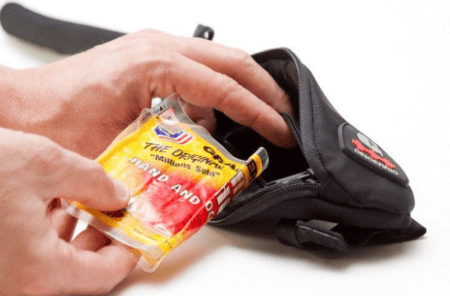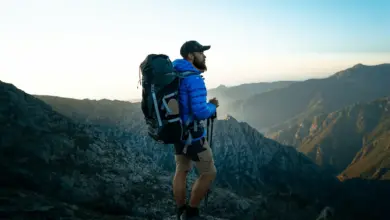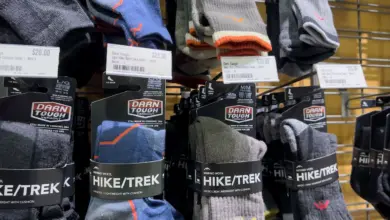How to Prevent Your Hydration Pack from Freezing
How to Prevent Your Hydration Pack from Freezing
Camelbaks and pretty much all bladders are a huge problem in the winter, especially on extended hikes. The hose freezes and the bladder becomes unusable. While convenient in the summer, hydration packs in cold weather have a lot of disadvantages. But, there are a few tricks you can do to prevent your hydration pack from freezing.
So, how do you keep a hydration pack from freezing? The best way to prevent a hydration pack from freezing is not to use one. But, if you are using one, insulating the hose, blowing air back into the tube, keeping the pack close to your body, and using warm water will all help prevent hydration packs from freezing.
How to Prevent Your Hydration Pack from Freezing
Here are some tips for preventing hose freeze-ups when hiking:
- Purchase an insulated tube cover (available on Amazon) Of course, these don’t make your hydration hose freeze-proof, but they do help. They also help keep your water cool in the summer, so you can use it year-round.
- Insulate the bladder itself. You can create a homemade drink cozy out of fleece.
- Start with hot water (not boiling) to prolong the time it takes to freeze.
- Sip often. Not having water sit too long in the hose will prevent freezing.
- Blow water back into the bladder after each sip. The less water that stays inside the tube, the less chance it has of freezing.
- Keep the bladder covered at all times, preferably close to your body. You can even tuck it inside your shirt or sleeve.
- Wrap a heat warmer in a sock and place it against the bladder.
Some people say adding sugar, electrolytes, or even 4.5oz of vodka will help prevent freezing. I haven’t tried this method and while it sounds nice, I doubt it will have any significant effect. To make this method effective, you probably need to add a lot to the water, which will only make you more thirsty.
But really, the real solution to preventing your bladder from freezing is not using a bladder at all to avoid the problem altogether. I’ve even heard stories of entire bladders freezing, where hikers cut their bladders to remove the 2 lbs of solid blocks of ice!
Even if you can manage to prevent your bladder and hose from freezing, it’s extra steps and maintenance and risk that I would rather not deal with. There are a lot more variables and risk when winter hiking, and carrying a hydration pack in cold weather simply adds more complexity.
If you’re going on a day hike and know the temperature isn’t going to get too cold, then you’re probably going to be fine. It’s all about personal preference and risk management.
You may also like Ways to Carry Your Tripod Hiking
Why I Stopped Using Hydration Packs
I stopped using hydration packs in general, except on day hikes in the summer. I find them to have a lot of disadvantages over water bottles.
Why I don’t think hydration packs are a good idea:
- They can freeze
- Are harder to refill
- Are more prone to damage (rips, punctures, and leaks)
- Take up room in your pack
- Are harder to clean
- Can get funky and taste bad
- And you can’t tell how much water is left
And if you’re doing any serious hiking, the risk is not worth it. It’s always better to bring a water bottle anyway. When you’re carrying two water bottles, you’re always going to have a backup. Plus, when you’re not using your bladder sleeve in your pack, it’s a nice way to store other items. My snow saw fits really nicely in my pack’s bladder compartment and doesn’t move around.
Water bottles just offer a lot more advantages over hydration packs. They are easier to fill, leave more space in the pack, and are just more reliable. It’s always a good idea to carry a water bottle along with a hydration pack as a backup. Wide-mouth bottles are the easiest to deal with and have a lot fewer problems.
One trick to keeping water bottles from freezing is to keep them upside down. This will prevent any water inside the threads from freezing. Oh yeah, wrap it in a cozy or add a few socks around it to keep it warm.
You may also like Hiking Without Underwear, Gross or Practical?
Insulated and Heated Hydration Packs
To be fair, there is some fancy equipment on the market that does help take care of this whole cold weather freezing problem. Of course, if temperatures are cold enough, only so much can help.
HydroHeater
One solution I came across online is the HydroHeater by a company called Arctic Innovations. I haven’t used this myself but found it pretty interesting. It’s basically an insulated hydration pack with a heating element that runs down the hose. It’s powered by a battery, keeping your water warm down to -40F, which is really cool.
One thing I don’t like the idea of is using battery power to stay warm unless I have a backup. Relying on a tiny battery is too risky for me.
Geigerrig Tube
Another solution that helps and is fairly simple is using the Geigerrig Tube. The Geigerrig Tube is a holster that attaches to your pack using velcro straps. It keeps your hose and bite valve out of the cold and wind. It has an inside pocket to add a heat warmer, which is pretty neat, and it works with pretty much any hydration pack. You can check it out on Amazon.
What Should I Do If My Hydration Pack Freezes?
Okay, so you’re hiking, it’s cold, and your bladder or hose freezes. What do you do?
- The most common culprit of freeze-ups is the mouthpiece freezing. This is the part that is most exposed. This is usually an easy fix by putting the mouthpiece inside your shirt and letting your body heat thaw the ice. You should put as much of the hose inside your clothes in case other parts are frozen as well.
- Another method for thawing the hose is putting it back inside the pack with a heat warmer. Keep it tucked in right next to the bladder. The warmer water from the bladder will help thaw the ice.
Some hydration packs come with removable tubes and mouthpieces, such as the military-grade CamelBaks. If you have such a pack, you have a much better chance of thawing the ice in the hose. Here’s what you can do:
- Flip the hydration pack upside down and remove the hose and bite valve. The idea is to not leak water everywhere when you do this.
- Put the hose and bit valve somewhere close to your body (inside the shirt pocket for example) and wait until it thaws.
You may also like Best Hiking Leggings With Pockets
What You Need to Know
If you’re doing any serious hiking, you should make sure you’re prepared. It’s still fairly easy to get dehydrated in the winter due to the dry air. If you want to bring a hydration pack in the cold, check the weather and know what you are getting into. Know how to keep your hose and bladder warm and how to fix it if it does freeze. I always preach testing your gear beforehand. And at the very least, bring a water bottle and be prepared in case anything goes wrong.




